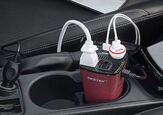Nissan Prepares to Rejoin the Competition With Next Wave of Electric Vehicles

Consumer demand may be the driving force behind automakers shifting assembly line production toward crossover vehicles, but there is another trend that has nothing to do with modern-day sales. Electric vehicles have a small but loyal consumer base and the majority of carmakers seem poised to ensure the next decade caters directly to them — whether it be through pure BEVs or hybridized powertrains.
However, not every manufacturer has its electrified ducks in a row. Despite hitting its mark with the Leaf EV, Nissan has been resting on its laurels since 2010 and hasn’t made the same sort of technological promises that Volkswagen Group or Ford cannot help but keep repeating… over and over again. Nissan’s chief planning officer Philippe Klein even admitted in January that his company’s EV prospects are dim and something needs to be done.
“Five or six years ago, we were looked at as a kind of adventurous company, moving into an area where nobody was expecting us to move,” Klein told Automotive News. “And now you have a lot of players making big announcements, and we are looked at like laggards.”
Fortunately, Nissan’s new CEO Hiroto Saikawa says the business has started taking steps to ensure it is not left behind in the next decade — starting with the alleviation of range anxiety. Saikawa says automakers, including Nissan, should have something to calm Leaf owners’ nerves before 2020. However, he admitted that may only apply to customers in Japan and Europe, who usually put fewer miles on the odometer.
When we asked Nissan to confirm whether or not the next-generation Leaf would make it to North America, it responded with, “As a matter of policy, we do not discuss future product plans.”
However, we have it on good authority that the Leaf will continue to persist in Canada and the United States. It just might not possess the range required to appease our vehicular sensibilities. But Saikawa says something electric is coming with a range above 300 miles within the next couple of years — and it should be joined by an array of hybrid and all-electric models between 2020 and 2025.
“The real evolution will come when we have a serious plan for the substitution of existing powertrains, say in our major models: the Rogue, Qashqai, X-Trail. A major part of it will be EV. This is the time I’m talking about. Maybe 2025,” Saikawa explained.
“But the period of differentiating ourselves by technology is almost over. Then, [it] will be a competition of how aggressively you can deploy the portfolio across the models. We would like to be on the aggressive side, the leading side.”
[Image: Nissan]

Consumer advocate tracking industry trends and regulations. Before joining TTAC, Matt spent a decade working for marketing and research firms based in NYC. Clients included several of the world’s largest automakers, global tire brands, and aftermarket part suppliers. Dissatisfied, he pivoted to writing about cars. Since then, he has become an ardent supporter of the right-to-repair movement, been interviewed about the automotive sector by national broadcasts, participated in a few amateur rallying events, and driven more rental cars than anyone ever should. Handy with a wrench, Matt grew up surrounded by Detroit auto workers and learned to drive by twelve. A contrarian, Matt claims to prefer understeer and motorcycles.
More by Matt Posky
Latest Car Reviews
Read moreLatest Product Reviews
Read moreRecent Comments
- Rrp138519787 If Jeep wanted to re-introduce the Wagoneer name, they just should have named the Grand Cherokee L the Wagoneer instead, and done a little bit more styling differentiation. They could have done a super deluxe version as the Grand Wagoneer. But all Wagoneers would have been the three row version as the primary product differentiation. And would cause less confusion for consumers overall.
- D The only people who have TDS, which I assume is Trump Derangement Syndrome, are the MAGOTS who have been brainwashed to love him. They Know Not What They Do.
- The Oracle The updated Model Y beat this copy to market.
- ToolGuy™ I respect what the seller is doing, but this vehicle is not for me. (Seller doesn't care, has two people lined up already.)
- SCE to AUX How well does the rear camera work in the rain and snow?


































Comments
Join the conversation
Would anyone get excited if Nissan announced a new gasoline 50 mpg commuter car with a 4 gallon tank, a refueling nozzle the diameter of a drinking straw, and a weak heater and A/C unit that cut range by 1/3 if they are actually used in hot or cold weather?
I do believe that given the current state of battery technology and driving conditions in the U. S., that the PHEV is a better choice than an BEV for most drivers. Having driven one for the last three years has made me a believer. Once you do your in-town driving in an EV, it's tough to go back.